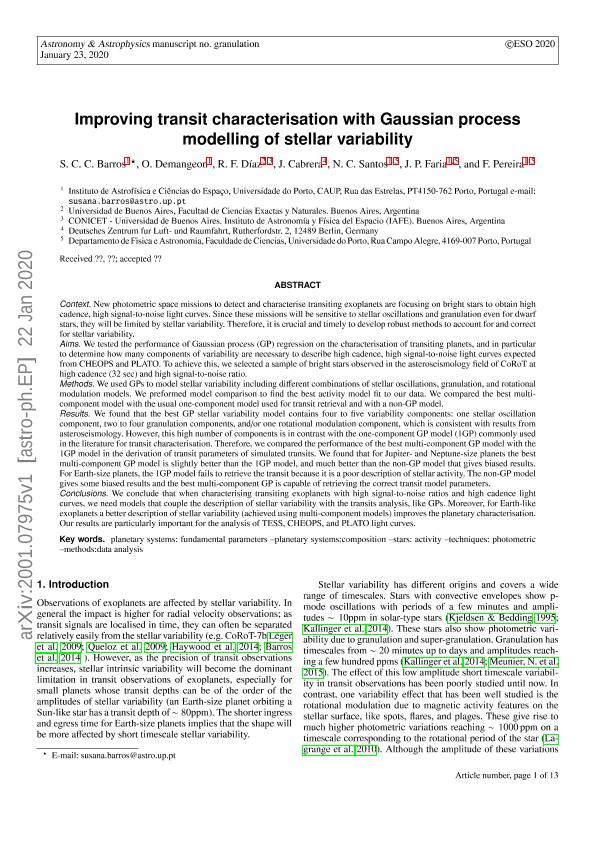Mostrar el registro sencillo del ítem
dc.contributor.author
Barros, S. C. C.
dc.contributor.author
Demangeon, O.
dc.contributor.author
Diaz, Rodrigo Fernando

dc.contributor.author
Cabrera, J.
dc.contributor.author
Santos, N. C.
dc.contributor.author
Faria, J. P.
dc.contributor.author
Pereira, F.
dc.date.available
2022-09-09T16:21:20Z
dc.date.issued
2020-02
dc.identifier.citation
Barros, S. C. C.; Demangeon, O.; Diaz, Rodrigo Fernando; Cabrera, J.; Santos, N. C.; et al.; Improving transit characterisation with Gaussian process modelling of stellar variability; EDP Sciences; Astronomy and Astrophysics; 634; 2-2020; 1-13
dc.identifier.issn
0004-6361
dc.identifier.uri
http://hdl.handle.net/11336/168157
dc.description.abstract
Context. New photometric space missions to detect and characterise transiting exoplanets are focusing on bright stars to obtain high cadence, high signal-to-noise light curves. Since these missions will be sensitive to stellar oscillations and granulation even for dwarf stars, they will be limited by stellar variability. Therefore, it is crucial and timely to develop robust methods to account for and correct for stellar variability. Aims. We tested the performance of Gaussian process (GP) regression on the characterisation of transiting planets, and in particular to determine how many components of variability are necessary to describe high cadence, high signal-to-noise light curves expected from CHEOPS and PLATO. To achieve this, we selected a sample of bright stars observed in the asteroseismology field of CoRoT at high cadence (32 s) and high signal-to-noise ratio (S/N). Methods. We used GPs to model stellar variability including different combinations of stellar oscillations, granulation, and rotational modulation models. We preformed model comparison to find the best activity model fit to our data. We compared the best multi-component model with the usual one-component model used for transit retrieval and with a non-GP model. Results. We found that the best GP stellar variability model contains four to five variability components: one stellar oscillation component, two to four granulation components, and/or one rotational modulation component, which is consistent with results from asteroseismology. However, this high number of components is in contrast with the one-component GP model (1GP) commonly used in the literature for transit characterisation. Therefore, we compared the performance of the best multi-component GP model with the 1GP model in the derivation of transit parameters of simulated transits. We found that for Jupiter-and Neptune-size planets the best multi-component GP model is slightly better than the 1GP model, and much better than the non-GP model that gives biased results. For Earth-size planets, the 1GP model fails to retrieve the transit because it is a poor description of stellar activity. The non-GP model gives some biased results and the best multi-component GP is capable of retrieving the correct transit model parameters. Conclusions. We conclude that when characterising transiting exoplanets with high S/Ns and high cadence light curves, we need models that couple the description of stellar variability with the transits analysis, like GPs. Moreover, for Earth-like exoplanets a better description of stellar variability (achieved using multi-component models) improves the planetary characterisation. Our results are particularly important for the analysis of TESS, CHEOPS, and PLATO light curves.
dc.format
application/pdf
dc.language.iso
eng
dc.publisher
EDP Sciences

dc.rights
info:eu-repo/semantics/openAccess
dc.rights.uri
https://creativecommons.org/licenses/by-nc-sa/2.5/ar/
dc.subject
METHODS: DATA ANALYSIS
dc.subject
PLANETS AND SATELLITES: COMPOSITION
dc.subject
PLANETS AND SATELLITES: FUNDAMENTAL PARAMETERS
dc.subject
STARS: ACTIVITY
dc.subject
TECHNIQUES: PHOTOMETRIC
dc.subject.classification
Astronomía

dc.subject.classification
Ciencias Físicas

dc.subject.classification
CIENCIAS NATURALES Y EXACTAS

dc.title
Improving transit characterisation with Gaussian process modelling of stellar variability
dc.type
info:eu-repo/semantics/article
dc.type
info:ar-repo/semantics/artículo
dc.type
info:eu-repo/semantics/publishedVersion
dc.date.updated
2022-09-08T15:12:48Z
dc.journal.volume
634
dc.journal.pagination
1-13
dc.journal.pais
Francia

dc.description.fil
Fil: Barros, S. C. C.. Universidad de Porto; Portugal
dc.description.fil
Fil: Demangeon, O.. Universidad de Porto; Portugal
dc.description.fil
Fil: Diaz, Rodrigo Fernando. Consejo Nacional de Investigaciónes Científicas y Técnicas. Oficina de Coordinación Administrativa Ciudad Universitaria. Instituto de Astronomía y Física del Espacio. - Universidad de Buenos Aires. Facultad de Ciencias Exactas y Naturales. Instituto de Astronomía y Física del Espacio; Argentina
dc.description.fil
Fil: Cabrera, J.. No especifíca;
dc.description.fil
Fil: Santos, N. C.. Universidad de Porto; Portugal
dc.description.fil
Fil: Faria, J. P.. Universidad de Porto; Portugal
dc.description.fil
Fil: Pereira, F.. Universidad de Porto; Portugal
dc.journal.title
Astronomy and Astrophysics

dc.relation.alternativeid
info:eu-repo/semantics/altIdentifier/doi/http://dx.doi.org/10.1051/0004-6361/201936086
Archivos asociados
